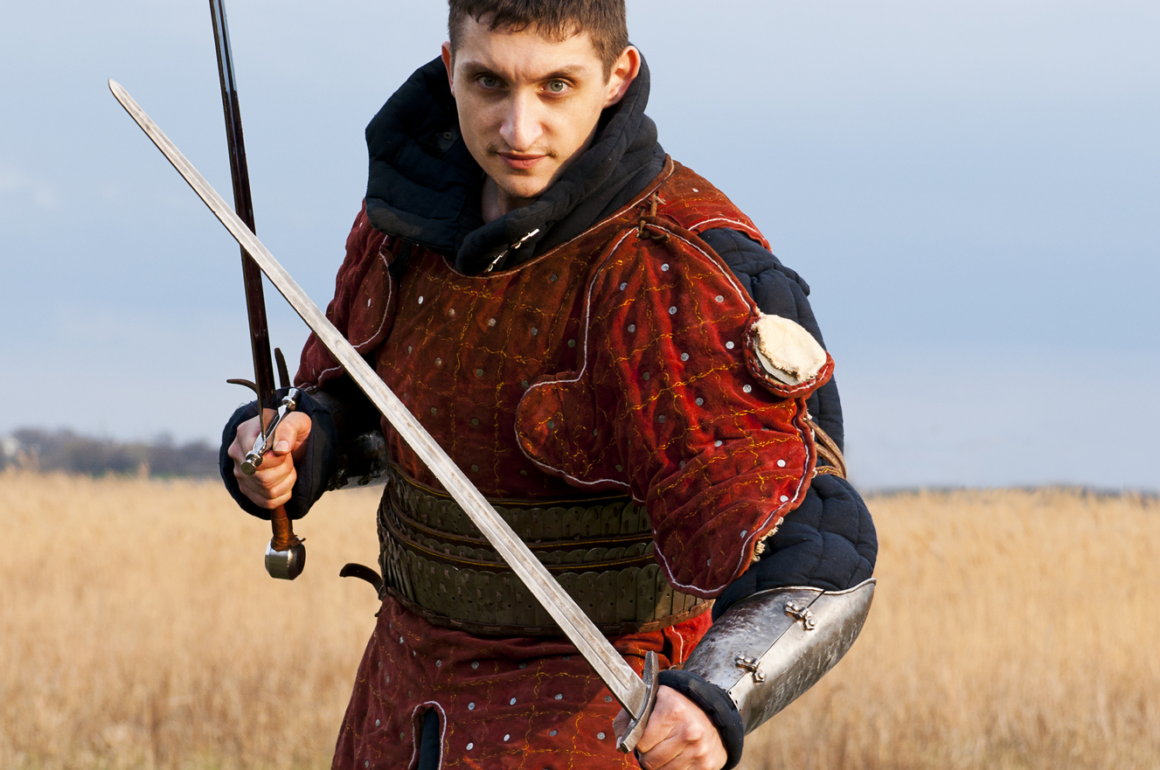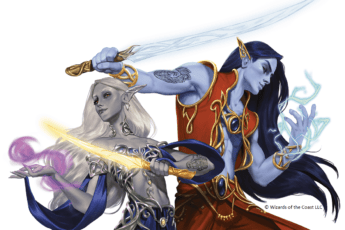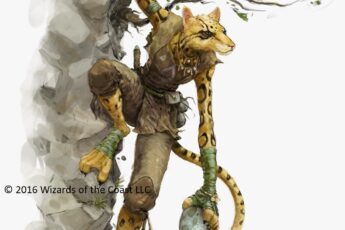
Two-weapon fighting is synonymous with D&D. But how does it work in 5e? Luckily, it’s not too complicated.
When you take an attack action and are wielding two light melee weapons, you can use your bonus action to make a second attack with your other weapon. If the weapons have throwing properties, you can throw them as well. The second attack does not include your modifier unless it is a negative.
What does the book say?
Page 195, Players Handbook
Two-Weapon Fighting
‘’When you take the Attack action and attack with a light melee weapon that you’re holding in one hand, you can use a Bonus Action to attack with a different light melee weapon that you’re holding in the other hand. You don’t add your ability modifier to the damage of the bonus attack, unless that modifier is negative.’’
‘’If either weapon has the Thrown property, you can throw the weapon, instead of making a melee attack with it.’’
Seems simple right? Now let us go through a step-by-step breakdown to understand this in combat.
Step-by-step breakdown.
Let’s say you are a level 1 Ranger wielding two short swords. When it’s your turn in combat it would go something like this.
- You move to your enemy and use your attack action with your first short sword.
- For your first attack, you get a +5 attack bonus. You roll a D20 and get 10, then add your attack bonus for a total of 15, and it’s a hit.
- 1st short sword damage is 1d6+DEX modifier (+3). You roll a D6 and get a 3 for damage and add +3 for your DEX modifier for a toll of 6 damage.
- Now, you decide to use your bonus action to make the second attack.
- For your second attack, you get a +5 attack bonus. You roll a D20 and get 11, then add your attack bonus for a total of 16, and it’s a hit.
- 2nd Short sword damage is 1d6, but no DEX modifier is added for the second attack. You roll a D6 for damage and get a 5, giving you a total of 5 damage.

Can everyone use two-weapon fighting?
Yes, everyone can use two-weapon fighting. It does not require any special features or feats. If you have a bonus action and the right weapons, you can two weapon fight.
What light weapons should I use?
Here is a list of all the best light weapons for two-weapon fighting. In descending order from best to worst.

Short Sword
A shortsword is one of the best weapons for two-weapon fighting. It is among the highest damage on the list (1D6), and the finesse quality is the perfect weapon for a dexterity-based two-weapon fighter.
Scimitar
When I read scimitar, all I ever think of is Drizzt Do’Urden, one of the most popular two-weapon fighters in the genre. The shortsword and scimitar are virtually identical in damage die and properties, except scimitars deal slashing damage while shortswords deal piercing.
Handaxe
Handaxes would be my choice for any strength-based two-weapon fighter. They’re in the higher light weapon dice damage range (1D6), and they have a throwing property range of 20/60.
Imagine a barbarian running into battle in a rage, slaying his first enemy with his handaxe, but oh no, he’s out of movement. Don’t worry. He throws his second handaxe at the nearest enemy, slaying them as well. Who wouldn’t love that? Probably your DM, but who cares about them.
Dagger
This classic weapon is great for rogues. Daggers deal less damage (1D4), but pairing it with a shortsword is one of my favorite two-weapon fighting combos for rogues. Just like handaxes, daggers have a throwing property range of 20/60, which adds a whole new dynamic to your two-weapon fighting style.
Light hammer
Nearing the bottom of the list is the light hammer. Unfortunately, not being a finesse weapon and having a lower damage die (1D4), one wonders why you would even bother with this weapon. The handaxe does more damage (1D6) and has the same throwing properties.
The unique thing about the light hammer is that it is one of two weapons on this list that deals bludgeoning damage.
Sickle & Club
The sickle and club are lumped together because they are terrible. Being the lower end of damage (1D4) and having no properties, finesse or throwing, these should be the last weapons you ever choose to two-weapon fight with, or to fight with in general. Seriously, they’re dreadful.
Using your bonus action.
Something to remember about two-weapon fighting is you must use your bonus action to attack with your second weapon.
Bonus actions are important. A lot of classes rely on them. Barbarians need them to rage; a fighter needs them for action surge or second wind; spellcasters sometimes use them to cast spells; rogues need them for cunning action.
When building your two-weapon character, consider seriously what your character would be using their bonus action for, if not two-weapon fighting. Then decide if it is worth it or not.

What is the best class for two-weapon fighting?
In no particular order, if I was building a two-weapon fighter, these are the best classes.
- Fighter
- Ranger
- Barbarian
- Rogue
Fighter
Whether you want to make a dexterity or strength-based two-weapon fighter, the fighter class is not a bad way to go.
Being able to choose two-weapon fighting as your fighting style at 1st level is a plus. You will immediately be able to do extra damage by adding your ability modifier to your second attack.
With the best armor proficiencies in our lineup, your strength-based fighter would have a higher armor class to make up for the lack of a shield.
You will also gain more feats over time, allowing you to improve your two-weapon fighting. Dual Wielding is a feat you definitely want to pick up. With an extra attack added on at level 5, you will be doing a decent amount of damage early on.
For your martial archetype, I would choose Battle Master. Having more attacks will allow you to use more Maneuvers.
Ranger
Rangers make a great dexterity-based two-weapon fighter, and I would stick with dexterity because of the lack of heavy armor proficiency. This way, both your armor class and your attack modifier go up with your ability score.
At second level, you can choose your fighting style. Choosing two-weapon fighting will allow you to add your strength or dexterity modifier to your second attack.
Most important for a two-weapon fighting Ranger is that they get spells, particularly Hunter’s Mark. After it is cast, it allows you to do an extra D6 die damage to any attack that hits, making your extra attacks from two-weapon fighting more effective.
A Ranger dual-wielding two shortswords would normally do 2D6 die damage if both attacks hit. If the Ranger cast Hunters Mark, then he would do 4D6 die damage if both attacks hit. Add extra attack at level 5, and you will be doing a lot more damage.
The only downside to Hunter’s Mark is that it requires a bonus action to cast. You will not be able to attack twice until your next turn after casting it. You can also use your bonus action to move Hunter’s Mark to a different enemy if you choose. The best thing to do would be to cast Hunter’s Mark on the toughest looking bad guy, then enjoy all the extra damage you would deal.
For the Archetype, go with Hunter or Gloom Stalker. All the other archetypes require you to use your bonus action for other things, which will get in the way of your two-weapon fighting.
Barbarian
Barbarians are an unlikely two-weapon fighter for most people, but hear me out. The one thing Barbarians do is rage.
After you use your bonus action to Rage, you will be able to use your rage bonus to deal damage for every attack. With extra attack coming in at level 5, you will have plenty of opportunities to hit while raging.
For a strength-based two-weapon fighter, I would highly recommend the Dual Wielding feat. This way, you can wield larger weapons, such as battleaxes or longswords that deal more damage, 1D8 compared to 1D6.
One of the biggest drawbacks for a two-weapon fighting barbarian is they do not get the chance to take Fighting Style. Therefore, they will never get to add their ability modifier to their second attack.
For this reason, I would suggest multiclassing into a Ranger for two levels. Then, you can take two-weapon fighting for your fighting style and gain spells, particularly Hunters Mark, which will add even more damage to your attacks after being cast. By your third round of combat in battle, you’d be doing damage from two attacks, with each getting modifier damage, plus your rage damage, plus Hunters Mark damage.
For your Primal Path, I would recommend Path of the Zealot. This will allow you to do extra damage 1D6 + half your barbarian level with your first hit with the Divine Fury feature. Since you’re two-weapon fighting, you have more of a chance to deal this damage.
Rogue
Two-weapon fighting is a good option for rogues as well. Rogues typically have high dexterity, so finesse weapons make perfect sense.
A rogue’s whole purpose in combat is to land their sneak attack. Two-weapon fighting gives them more chances to do so. Think about it; if a rogue worked hard to sneak up on someone or get into flanking and then missed their one attack, it would be devastating for them.
Two-weapon fighting helps lessen this problem. So you’ve missed with your first attack. Oh well, use your bonus action, and you have another chance to hit. This is everything for a rogue.
Keep in mind that rogues do not gain a fighting style or Extra Attack. For those reasons, two-weapon fighting is a good option for them.
My favorite archetype for a two-weapon fighting rogue is the Assassin, primarily for their assassination ability. If you attack somebody before they go in the combat order and hit, it is an automatic critical hit. Adding more attacks can be very deadly.
If you want to have a lot of fun, multiclass into a fighter and use action surge as well. Your DM will hate you.

Best Feats
A quick note before we get into the feats. I strongly recommend maxing out whichever ability score you are using for your two-weapon fighter (strength or dexterity) before taking any feats.
However, if you were playing a variant human, I would recommend taking Dual Wielder for your first level feat.
Dual wielder
Dual wielder is the most obvious choice for anyone building a two-weapon fighter.
What does the book say?
Page 165, Players Handbook
Dual Wielder
You Master Fighting with two Weapons, gaining the following benefits:
- You gain a +1 bonus to AC while you are wielding a separate melee weapon in each hand.
- You can use Two-Weapon Fighting even when the one-handed Melee Weapons you are wielding aren’t light.
- You can draw or stow two one-handed Weapons when you would normally be able to draw or stow only one.
The +1 to AC makes up a little for the lack of Shields. Not having to use light weapons also will allow you to up your die damage with bigger weapons, such as longswords, battleaxes, or rapiers.
Though I don’t know many DM’s, who are sticklers for drawing or stowing weapons, it is still good to have if it ever comes up.
Magic Initiate
Only consider this feat if you are a barbarian, fighter, or rogue. Magic initiate will allow you to take a first-level spell. You should take Hex.
This will allow you to add more damage, 1D6 per attack, just like Hunters Mark does for the Ranger.
What does the book say?
Page 168 Players Handbook
Magic Initiate
Choose a class: bard, Cleric, druid, Sorcerer, Warlock, or Wizard. You learn two Cantrips of your choice from that class’s spell list.
In addition, choose one 1st-level spell from that same list. Using this feat, you can cast the spell once at its lowest level, and you must finish a Long Rest before you can cast it again.
Your Spellcasting Ability for these Spells depends on the class you chose: Charisma for bard, Sorcerer, or warlock; Wisdom for Cleric or druid; or Intelligence for Wizard.
Mobile
Mobile is not necessary, but it can definitely help with your two-weapon fighter.
What does the book say?
Page 168 Players Handbook
Mobile
You are exceptionally speedy and agile. You gain the following benefits:
- Your speed increases by 10 feet.
- When you use the Dash action, Difficult Terrain doesn’t cost you extra Movement on that turn.
- When you make a melee Attack against a creature, you don’t provoke Opportunity Attacks from that creature for the rest of the turn, whether you hit or not.
Mobile will allow you to get to your enemies quicker so you can ultimately deal more damage.
It is particularly good for a rogue who will not be able to use their cunning action when two-weapon fighting.
Lucky
Lucky is one of those feats that anybody could take, and it would be useful. However, the opportunity to reroll missed attacks would be great for your two-weapon fighter.
What does the book say?
Page 167 Players Handbook
Lucky
You have inexplicable luck that seems to kick in at just the right moment.
You have 3 luck points. Whenever you make an Attack roll, an ability check, or a saving throw, you can spend one luck point to roll an additional d20. You can choose to spend one of your luck points after you roll the die, but before the outcome is determined. You choose which of the d20s is used for the attack roll, ability check, or saving throw.
You can also spend one luck point when an Attack roll is made against you. Roll a d20, and then choose whether the attack uses the attacker’s roll or yours.
If more than one creature spends a luck point to Influence the outcome of a roll, the points cancel each other out; no additional dice are rolled.
You regain your expended luck points when you finish a Long Rest.

FAQ’s About Two-Weapon Fighting
What is two-weapon fighting 5e?
In D&D 5E, if you are wielding light weapons in both hands, two-weapon fighting allows you to make two attacks in one turn. The first attack will use your attack action, and the second is dealt with your bonus action.
Can a fighter dual wield Longswords?
If you want to dual wield longswords, or any non-light one handed weapon, you must take the Dual Wielder feat.
Can anyone use two weapon fighting?
Yes, if both weapons are light and you use your attack action, you can make a second attack with your bonus action no matter what your class.
Is two weapon fighting good in D&D?
Yes, two-weapon fighting is good in 5E. Is it the most optimal amount of damage you will do per round? No, but I would not base your decision on that.
For me, in role-playing games, characterization is what’s most important. If you want your character to be a dual wielder because you like it, it helps with your character’s story, or for any other reason, it is worth it.
There is no right or wrong, there is only your imagination.





Leave a Comment